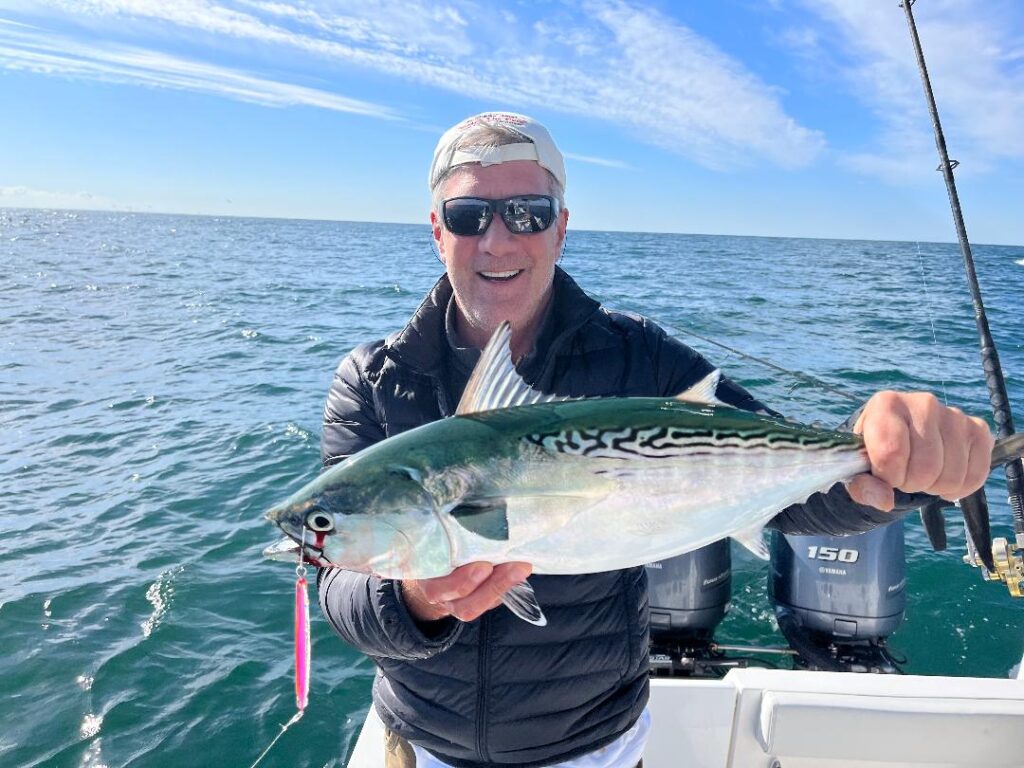The gem of the fishing season is here – October. Crisp fall temperatures pushing water temps down and triggering migrations create a perfect scenario for the season finale. False albacore, porgies, sea bass, fluke, tuna and blackfish are all in play this month, but the true star of October is striped bass.
The striper migration is underway as these majestic fish return south from as far away as Maine and Nova Scotia. Gorging and fueling themselves on bunker, herring, mackerel, and sand eels, this is the last shot to get a trophy. Even though it was a disappointing spring with the late arrival of bunker on most of the east end, there are plenty of pods around now. Find the bait, find the fish. For those who swear by bait fishing, if possible, the best scenario is to throw a cast net at an undisturbed pod in the back bays and have your live well stuffed when heading out. If that’s not an option, casting a bunker snag and getting single pieces will suffice. Cast past the pod, wait for a 5 count, then start retrieving with sharp pulls. There will be times, especially this month, with so many fish around you may not get a bunker back to the boat before a bass hits it. When this happens, make a quick hook set and efficiently fight the fish. A weighted treble can be a death sentence for a big migrator with many years of spawning ahead of her. Have a conventional or spin setup ready to go with a circle hook so you can quickly redeploy a snagged bunker. A pod that’s getting worked over by a school of overslot-size stripers is quite a sight. Take full advantage of it when you do see it. Set up the drift up current of the pod and to either side. The edges are where the bass will be looking for an easy snack that an injured bunker, like the one on your circle hook, will be.

A live well full of bunker isn’t necessary, though. Flutter spoons, surface plugs, diamond jigs, and soft plastics can be just as effective in October with hungry fish on the move. The doc is hands down one of the best plugs to work for a topwater bite in the fall. Mimicking an injured flailing bunker, the bites it triggers are amazing. Slow cadence on the retrieve with the rod parallel to the water and twitches every few cranks of the reel will induce the plug to work in the side-to-side, walking the dog action stripers can’t resist. If you’re marking bait and fish and not getting bites, slow down the retrieve and twitches and pause between twitches. Some of the best takes happen when a bass is tracking the plug and it’s perfectly still. Consider swapping out the tail treble for a single hook and crushing the barbs. It’s going to make life a lot easier boatside while landing the fish and minimizing damage to a fish that, with the current slot limit, is going to be released. It’s hard to think that the population has pressure on it in the fall with fish everywhere, but there is. Nobody wants to see regulations increase and possible drastic actions because of the release mortality being one of the big factors that regulators look at. Flutter spoons jigged on those same drifts you’d work a live bunker on, get bit and get bit often. That same injured bait profile on top with a doc works at the bottom of the water column.
Bunker isn’t the only bait they’re feeding on. Like the abundance of sand eels last fall and this year on the tuna grounds, chances are those clouds just below the surface on your screen are them. The most basic and user-friendly lure is the go-to, a diamond jig. Vertically jigged and or cast and retrieved, the time-proven profile and simplicity will raise fish.
Last chance for a doormat fluke is on the table until the 11th. It was a solid season this year and there are still some big flatties around in the ocean. Gulp and Fishbites have consistently out-fished spearing and squid. High-low setups with a bucktail on the bottom and a teaser or small bucktail above are pretty much the standard now, instead of a 3-way swivel with a sinker and single hook with a skirted bait or artificial.
Blackfish, arguably one of the best eating of the inshore species, are in season starting October 15th. The debate will go on for years about what the right rig is, and more times than not in recent years it’s been a jig. In the wide expanse of wrecks, rock piles, and reefs that tautog love to call home current is going to dictate if a jig makes sense. The boulder fields of the north fork by Plum Gut call for lead sinkers in the double digits and a jig isn’t the call. 15-20 feet of water in the structure of the western sound with manageable water movement is a perfect scenario to put an Asian crab on a jig and work it.
It’s almost over, but not quite yet. Any chance to fish this month, take it!
